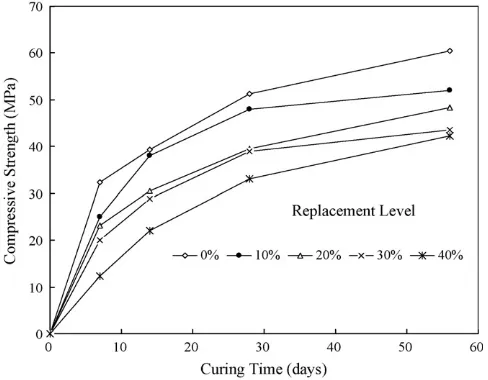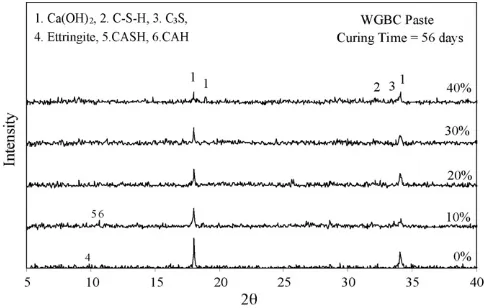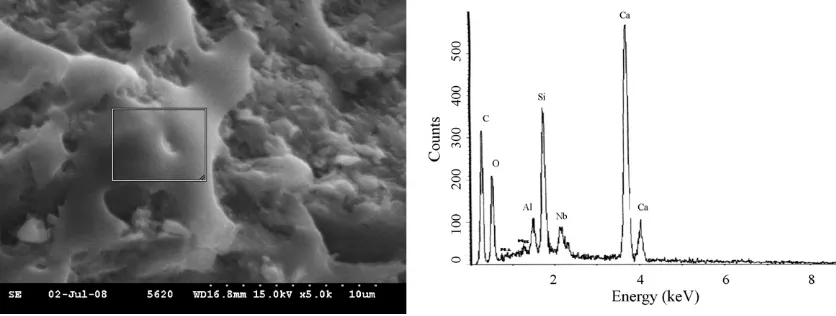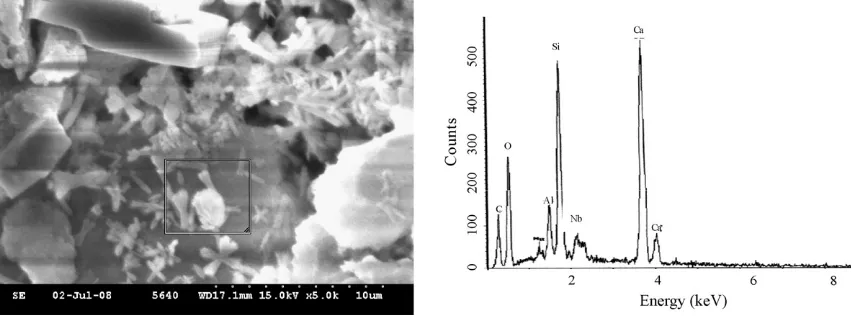Other uses, including reproduction and distribution, or selling or
licensing copies, or posting to personal, institutional or third party
websites are prohibited.
In most cases authors are permitted to post their version of the
article (e.g. in Word or Tex form) to their personal website or
institutional repository. Authors requiring further information
regarding Elsevier’s archiving and manuscript policies are
encouraged to visit:
Contents lists available atScienceDirect
Journal of Hazardous Materials
j o u r n a l h o m e p a g e :w w w . e l s e v i e r . c o m / l o c a t e / j h a z m a t
The utilization of thin film transistor liquid crystal display waste glass as a
pozzolanic material
K.L. Lin
a,∗, Wu-Jang Huang
b, J.L. Shie
a, T.C. Lee
c, K.S. Wang
d, C.H. Lee
eaDepartment of Environmental Engineering, National Ilan University 1, Section 1, Shen Lung Road, Yi-Lan City 26047, Taiwan, ROC bDepartment of Environmental Science and Engineering, National Pingtung University of Science and Technology, No. 1, Shuehfu Road,
Neipu, Pingtung 91201, Taiwan, ROC
cDepartment of Civil and Disaster Prevention Engineering, National United University, Lienda, Miaoli 36003, Taiwan, ROC dGraduate Institute of Environmental Engineering, National Central University, Chung-Li 320, Taiwan, ROC
eDepartment of Environmental Engineering, Da-Yeh University, Chang-Hua 515, Taiwan, ROC
a r t i c l e
i n f o
Article history:
Received 7 November 2007 Received in revised form 9 July 2008 Accepted 9 July 2008
Available online 17 July 2008
Keywords:
Thin film transistor liquid crystal display Waste glass
Strength activity index Gel/space ratio Degree of hydration
a b s t r a c t
This investigation elucidates the pozzolanic behavior of waste glass blended cement (WGBC) paste used in thin film transistor liquid crystal displays (TFT-LCD). X-ray diffraction (XRD) results demonstrate that the TFT-LCD waste glass was entirely non-crystalline. The leaching concentrations of the clay and TFT-LCD waste glass all met the current regulatory thresholds of the Taiwan EPA. The pozzolanic strength activity indices of TFT-LCD waste glass at 28 days and 56 days were 89% and 92%, respectively. Accordingly, this material can be regarded as a good pozzolanic material. The amount of TFT-LCD waste glass that is mixed into WGBC pastes affects the strength of the pastes. The strength of the paste clearly declined as the amount of TFT-LCD waste glass increased. XRD patterns indicated that the major difference was the presence of hydrates of calcium silicate (CSH, 2= 32.1◦), aluminate and aluminosilicate, which was present in WGBC pastes. Portland cement may have increased the alkalinity of the solution and induced the decomposition of the glass phase network. WGBC pastes that contained 40% TFT-LCD waste glass have markedly lower gel/space ratios and exhibit less degree of hydration than ordinary Portland cement (OPC) pastes. The most satisfactory characteristics of the strength were observed when the mixing ratio of the TFT-LCD waste glass was 10%.
© 2008 Elsevier B.V. All rights reserved.
1. Introduction
Waste electrical and electronic equipment (WEEE) can be diverse and complex, in terms of constituent materials, actual com-ponents and the process of manufacture. Characterization of this type of waste is extremely important in developing a cost-effective and environmental friendly recycling system[1]. The recycling of WEEE is important, not only in waste treatment but also in the recovery of valuable materials. Valuable materials and hazardous substances must be identified and quantified for the development of a cost-effective and environmental friendly recycling system. Additionally, an understanding of the physical characteristics of the waste stream is critical[2]. In Taiwan, the amount of waste glass that is dumped into landfills has accumulated to approxi-mately 0.52 million tons, while the amount of thin film transistor liquid crystal display (TFT-LCD) waste glass has reached 6000
∗ Corresponding author. Tel.: +886 3 9357400x749; fax: +886 3 9364277.
E-mail address:[email protected](K.L. Lin).
tons[3]. Of all of the liquid crystal displays (LCDs), the TFT-LCD has some particular advantages. It is thinner, smaller and lighter than other displays; it has low power consumption, low radia-tion, high contrast and high dpi. Accordingly, TFT-LCD panels are extensively adopted in everyday electronic products, and demand for them is increasing. However, this increased demand has also led to a significant increase in substantially increased amount of TFT-LCD waste glass that is produced. Traditional treatments of TFT-LCD waste glass are insufficient to satisfy the WEEE direc-tives.
Some other countries have for long time made substantial effort to recycle waste glass bottles. A bottle recovery system, through which empty bottles that have previously contained alco-holic beverages, soft drinks, condiments, milk and other liquids, are collected, washed and reused, has already been established. Addi-tionally, broken bottles and bottles that have previously contained chemicals, cosmetics and other substances are melted down for reuse or are crushed and turned into paving material, construction block material, glass marble, glass tile, glass fiber, lightweight blow-ing agents and other materials[4,5]. The use of recycled materials
in construction is very appealing, because much of such materials can be thus consumed; quality requirements are frequently low, and construction sites are widespread. It is important to recognize that the reactivity of glass depends on its type and composition and physical features such as the presence of pores and separate solid phases in the glass[6]. Shao et al. verified that ground glass having a particle size finer than 38m did exhibit a pozzolanic
behavior[7]. Shayan and Xu studied the utilisation of waste glass in concrete[8]had shown that both fine glass powder (GLP) of <10m particle size, and crushed glass aggregate could be used
in concrete together without adverse effects on concrete durabil-ity. Finely ground glass powders exhibited very high pozzolanic activity. The finer the glass powder is, the higher its pozzolanic reactivity is. An increase in curing temperature accelerates the activation of pozzolanic reactivity of both glass powder and coal fly ash in terms of strength development rate. The rapid mor-tar bar expansion test (ASTM C1260) results indicate that the replacement of Portland cement with ground glass powder also reduces the expansion due to alkali-aggregate reactions[9]. Pri-mary construction applications include the partial replacement of aggregate in asphalt concrete and use as fine aggregate, in pipe beds, in landfill gas venting systems and as gravel backfill for drains
[9].
Since TFT-LCD waste glass contains such a large amount of glass
[10], its recycling and reuse as a construction material has become a favored of treatment in Taiwan. Consequently, the recyclability of TFT-LCD waste glass as a pozzolanic material is evaluated. The goal of this study is to elucidate the strength of TFT-LCD waste glass when it is alkaline-activated, and to investigate its hydration products.
2. Materials and methods
2.1. Materials
The TFT-LCD waste glass was obtained from a TFT-LCD manufac-turing plant in Taiwan. The TFT-LCD waste glass was homogenized; oven dried at 105◦C for 24 h; and then the chemical
composi-tion was characterized. American Society for Testing and Materials (ASTM) Type I Portland cement (OPC) from the Taiwan Cement Company was used in this study. It had a specific gravity was 3.15 and its physical–chemical properties met the requirements of ASTM C150. The major composition of the OPC is shown inTable 1.
Table 1
Composition of the ordinary Portland cement and TFT-LCD waste glass
Portland
SiO2 21.65 64.74 72.50
CaO 63.70 20.19 9.18
Alkali content 0.42 0.38 13.27
Pozzolanic activity index (%)
2.2. Preparation of TFT-LCD waste glass
The TFT-LCD waste glass was then further pulverized in a ball mill until the particles could pass through a #200 mesh sieve. The TFT-LCD waste glass had a fineness value (on Blaine) of approx-imately 370 m2/kg, with a specific gravity of 2.79. The resultant pulverized TFT-LCD waste glass was desiccated before being tested. The pozzolanic activity of TFT-LCD waste glass cured for 28 days was analysed according to ASTM C311, and the results are also presented inTable 1.
2.3. Preparation of TFT-LCD waste glass blended cement paste specimens
TFT-LCD waste glass blended cement (WGBC) pastes were pro-duced by homogeneously mixing cement and water in a mixer. The levels of TFT-LCD waste glass substitution in the blended cement were between 10% and 40% by weight of the cement. The water/binder (w/b) ratio of the WGBC paste was a constant of 0.4. WGBC paste cubes were prepared according to ASTM C109. The WGBC paste was poured into rectangular moulds, which were kept under ambient conditions for 24 h before being de-moulded. The specimens were then cured in an environmental chamber main-tained at 25◦C, with a relative humidity greater than 98%, for
periods ranging from 1 day to 56 days. After curing for 7 days, 14 days, 28 days and 56 days, the samples were subsequently crushed. The hydration reactions were stopped with absolute alcohol. The samples were filtrated in a vacuum, washed several times with acetone and dried. Finally, the prepared samples were subjected to X-ray diffraction (XRD), gel/space ratios and degree of hydration analyses.
2.4. Analysis methodology
The major analyses performed on the WGBC pastes and its cube specimens included the following:
(1)Pozzolanic activity index: The test was performed according to ASTM Designation C 311.
(2)Setting time: The setting times of the cement mixes were deter-mined according to ASTM C191 using a Vicat apparatus at room temperature. The initial setting time occurred when a Vicat needle 1 mm in diameter penetrated the sample to a point 5±1 mm from the bottom of the mould. The final setting time was defined as when a 5-mm cap ring would leave no visible mark when placed on the surface of the sample.
(3)Unconfined compressive strength(ASTM C39-72): At each test-ing age, four specimens were taken out of the moist room. The surfaces of the specimen were polished to make the two bear-ing surfaces flat and parallel. Three specimens were used for the compressive strength tests and one for the microstructural examination. The average strength value of the three specimens is presented. The coefficient of variation of these results was less than 10%.
(4)Toxic characteristic leaching procedure(TCLP): SW 846–1311. (5)Leaching concentration: Cd (SW 846–7131A), Pb (SW 846–7421),
Zn (SW 846–7951), Cu (SW 846–7211), Cr (SW 846–7191) (6)Mineralogy: The XRD analyses were carried out by a Siemens
D-5000 X-ray diffractometer with Cu K␣radiation and 2
scan-ning, ranging between 5◦and 70◦. The XRD scans were run at
0.05◦-increments, with a 1 s counting time.
igni-tion method. The hydraigni-tion degree of the WGBC pastes was then
where˛is the hydration degree (%),Xis the gel/space ratio (%), nis the evaporated water in the completely hydrated specimen, thenis equal to 0.24 for OPC paste, W105, W580, and W1007are the sample weights at 105◦C, 580◦C, and 1007◦C, respectively
(g), 41: mass ratio was 1 mol H2O to 1 mol CO2,Wis the amounts of water (%),Cis the amounts of cement (%), andPis the amounts of TFT-LCD waste glass.
(8)SEM/EDX observation: The WGBC paste samples examination by the scanning electron microscope (SEM) equipped with an energy-dispersive X-ray (EDX) analytical system to determine the microstructural observation of the WGBC pastes and the compositions of the phases identified. The TFT-LCD glass and WGBC pastes was analysed by electron beam using Hitachi S-800. The beam was applied at 10 keV.
3. Results and discussion
3.1. Chemical characteristics of TFT-LCD waste glass
Chemical analysis (Table 1) demonstrates that the TFT-LCD waste glass sample is relatively rich in SiO2 and has a relatively low percentage of Na2O and a little indium-tin-oxide (ITO)[3]. The use of ITO to coat the LCD increases its transparency and conductiv-ity by reducing the charge on the substrate surface. The mineralogy composition was determined from an XRD pattern, as presented in
Fig. 1. XRD showed that the glass was entirely non-crystalline. The leaching concentrations of the TFT-LCD waste glass met the Taiwan EPA’s current regulatory thresholds (Table 2). It had a pozzolanic strength activity index of 89% and 92% at 28 days and 56 days, respectively. From the perspective of strength, it can be regarded as a good pozzolanic material.
3.2. Setting times of WGBC pastes
Table 3presents the setting times of WGBC pastes that contain TFT-LCD waste glass. A wide variability in the setting behavior of WGBC pastes is observed, with initial times in the range 4 h:11 min to 5 h:00 min, and final times in the range 6 h:15 min to 7 h:00 min. The results of the tests indicated that the initial and final setting
Fig. 1.XRD patterns of TFT-LCD waste glass.
Table 2
TCLP concentrations of TFT-LCD waste glass
Sample (mg/L) TFT-LCD waste glass
Cu 0.25
Set times of WGBC pastes
Initial set Final set
times of the WGBC pastes exceeded those of the OPC paste. The setting times increase with the amount of TFT-LCD waste glass. The relatively long setting times of WGBC pastes may follow from its containing of more SiO2than is in the OPC.
3.3. Compressive strength development
Fig. 2plots the compressive strengths of WGBC pastes at various ages of up to 56 days. The figure indicates the effect of the amounts of TFT-LCD waste glass mixed with the paste on its strength devel-opment. It reveals that the paste strength clearly declined as the amount of TFT-LCD waste glass increased. Increasing the amount of TFT-LCD waste glass reduced the strength in all stages. The lower strength of the WGBC paste alone is attributed to the high SiO2 con-tent. When the TFT-LCD waste glass replacement level was 40%, the compressive strength of the WGBC paste had decreased to 35% at 28 days and 30% at 56 days. The WGBC pastes that contained 40% TFT-LCD waste glass exhibited the lowest compressive strengths at all ages.
Fig. 3.XRD patterns of WGBC pastes after 56 days.
3.4. XRD patterns of WGBC pastes
Fig. 3plots the hydration products of OPC and WGBC pastes after various curing times for the four replacement levels, as revealed by XRD. The peaks indicate portlandite (2= 17.5◦, 33.8◦ and 47.6◦),
ettringite (2= 15.7◦) and some unreacted C
3S (33.1◦). The major difference was the presence of hydrates of calcium silicate (CSH, 2= 32.1◦), aluminate (CAH, 2= 11.9◦) and aluminosilicate (CASH,
2= 10.6◦), which was present in WGBC pastes. The
aforemen-tioned constituents differ from those of unreacting or partially reacting glass, and may reflect the composition of the pozzolanic reaction product. The glass phase of the TFT-LCD waste glass then reacted with the alkalis, rupturing the Si-O-Si links, forming new hydrated calcium silicate and hydrated calcium aluminates in the solution.
3.5. Gel/space ratios in WGBC pastes
The compressive strength of concrete (is well known to depend on the gel/space ratio as determined from the degree of cement hydration and thew/c ratio. A gel/space ratio is defined as the ratio of the volume of the hydrated cement to the sum of the vol-umes of the hydrated cement and the capillary pores[11].Fig. 4
presents gel/space ratios of the WGBC pastes. The gel/space ratio of the WGBC pastes clearly increased with the curing time and decreased as the amount of TFT-LCD waste glass increased.
Vari-Fig. 4.Gel/space ratios of WGBC pastes.
ous reaction products, including hydrates of calcium silicate (CSH), aluminate (CAH) and aluminosilicate (CASH), were also expected to form with consequent consumption of Ca(OH)2. This leads to a more densified and more homogeneous system, and a consider-able long-term strength increase. Notably, the volume change of SiO2in a pozzolanic reaction is caused by the production of CSH in the reaction—possibly because of the lower density of the poz-zolanic hydration products, potentially causing the filling of the pores. On the other hand, it is also noted that the volume change of SiO2 is larger than the Portland cement. This may be partially due to the lower density of the pozzolanic hydration products, and may indicate that pozzolanic reaction products are more effective in filling pores[12]. WGBC pastes that contain 10% TFT-LCD waste glass did not exhibit a significant decreases in gel/space ratios. Therefore, the most satisfactory characteristics of the strength were observed when the mixing ratio of the TFT-LCD waste glass was 10%.
3.6. Degree of hydration of WGBC pastes
Fig. 5plots the degree of hydration of the WGBC pastes. The degrees of hydration of the OPC pastes were 69% and 75% at ages of 28 days and 56 days, respectively. The degree of hydration in WGBC pastes depends on the percentage of the TFT-LCD waste glass replaced. The WGBC pastes with a lower TFT-LCD waste glass replacement level exhibited greater hydration. The lower degree of hydration associated with higher replacement levels of TFT-LCD waste glass is attributable to the availability of insufficient space to accommodate more hydration products. On the seventh day, the WGBS pastes that contained 10% TFT-LCD waste glass had a rela-tive Ca(OH)2content that is similar to that of the OPC pastes. At 56 days, the degree of hydration of WGBC pastes that contained 10% TFT-LCD waste glass increased to approximately 67%, perhaps because of the initial attack of TFT-LCD waste glass, which was involved mainly in the formation of C–S–H and the consumption of Ca(OH)2. The hydration of cement in the TFT-LCD waste glass pastes, as noted above. At 56 days, the degree of hydration of WGBC paste that contained 40% TFT-LCD waste glass was 1.2 times of that at 7 days. The increase in the degree of TFT-LCD waste glass reaction corresponded to a fall in the Ca(OH)2content, revealing an active pozzolanic reaction. Notably, the TFT-LCD waste glass in the WGBC pastes with higher replacement levels typically exhibited a weaker reaction.
Fig. 6.SEM/EDX micrograph of OPC pastes after 56 days.
Fig. 7.SEM/EDX micrograph of WGBC pastes contained 10% TFT-LCD waste glass after 56 days.
3.7. Microstructural observation of WGBC pastes
SEM and EDX analysis were used to examine the WGBC paste samples. The locations of the EDX analyses are marked on each SEM image. Note that the peak height in the EDX spectra is proportional to the amount of element present. A brief summary of SEM/EDX analysis is given below.Fig. 6shows the typical composition of the OPC paste at ages of 56 days. It shows the paste in the OPC paste, which is greatly enriched in Si and Ca. The WGBC paste contained 10% TFT-LCD waste glass was found to have been enriched with
silica, as expected (Fig. 7). The compositions mentioned above were different from that of partially reacted glass, and may reflect the composition of the pozzolanic reaction product. The composition of the WGBC paste contained 20% TFT-LCD waste glass also showed enrichment in silica, and assimilation of fine glass particles into the paste was clearly noted (Fig. 8). WGBC paste contained 30% TFT-LCD waste glass exhibited features similar to those of WGBC paste contained 20% TFT-LCD waste glass. Many other sites showed relics of TFT-LCD waste glass which were evidently consumed by the pastes, and EDX showed that the particles had been converted
Fig. 9.SEM/EDX micrograph of WGBC pastes contained 30% TFT-LCD waste glass after 56 days.
Fig. 10.SEM/EDX micrograph of WGBC pastes contained 40% TFT-LCD waste glass after 56 days.
to Si- and Ca-rich phases which also retained small amounts of Na (Fig. 9). The WGBC paste contained 40% TFT-LCD waste glass at ages of 56 days, appeared to have reacted in the paste (Fig. 10), but the reaction product had large amounts of Ca and small amounts of Na. Moreover, the SEM/EDX examination showed no deleterious reaction of TFT-LCD waste glass in the pastes due to insufficient alkali content of the paste and because TFT-LCD waste glass did not contribute alkali to the pore solution.
4. Conclusions
The results of this investigation can be summarized as follows. TFT-LCD waste glass contains a large amount of glass. The leaching concentrations of the clay and TFT-LCD waste glass all met the Tai-wan EPA’s current regulatory thresholds. TFT-LCD waste glass had a pozzolanic strength activity index of 89% and 92% at 28 days and 56 days, respectively. Its strength enables it to be regarded as a good pozzolanic material. The effect of the amount of TFT-LCD waste glass mixed into the WGBC pastes affects its strength. The strength of the paste clearly decreased as the amount of the TFT-LCD waste glass increased. XRD patterns indicated that XRD patterns indicated that the major difference was the presence of hydrates of calcium silicate (CSH, 2= 32.1◦), aluminate and aluminosilicate, which was
present in WGBC pastes. The Portland cement may have increased the alkalinity of the solution and induced decomposition of the glass phase network. The gel/space ratio and the degree of hydra-tion of the WGBC pastes that contained 40% TFT-LCD waste glass was substantially lower than those of the OPC pastes. WGBC pastes
that contain 10% TFT-LCD waste glass did not exhibit a significant decreases in gel/space ratios. Therefore, the most satisfactory char-acteristics of the strength were observed when the mixing ratio of the TFT-LCD waste glass was 10%.
References
[1] D. Lauren, O. Louise, Household recycling behaviour and attitudes towards the disposal of small electrical and electronic equipment, Resour. Conserv. Recycl. 44 (1) (2005) 17–35.
[2] J. Cui, E. Forssberg, Mechanical recycling of waste electric and electronic equip-ment: a review, J. Hazard. Mater. B 99 (2003) 243–263.
[3] K.L. Lin, Use of thin film transistor liquid crystal display (TFT-LCD) waste glass in the production of ceramic tiles, J. Hazard. Mater. 148 (2007) 91–97. [4] P. Craig, M.C. Steven, V. Rodolfo, Potential for using waste glass in portland
cement concrete, J. Mater. Civil Eng. 10 (4) (1998) 210–219.
[5] S.B. Park, B.C. Lee, J.H. Kim, Studies on mechanical properties of concrete con-taining waste glass aggregate, Cement Concrete Res. 34 (2004) 2181–2189. [6] A. Shayan, A. Xu, Performance of glass powder as a pozzolanic material in
concrete: a field trial on concrete slabs, Cement Concrete Res. 36 (2006) 457–468.
[7] Y. Shao, T. Lefort, S. Moras, D. Rodriguez, Studies on concrete containing ground waste glass, Cement Concrete Res. 40 (1) (2000) 91–100.
[8] A. Shayan, A. Xu, Value-added utilisation of waste glass in concrete, Cement Concrete Res. 34 (2004) 81–89.
[9] C. Shi, Y. Wu, C. Riefler, H. Wang, Characteristics and pozzolanic reactivity of glass powders, Cement Concrete Res. 35 (2005) 987–993.
[10] K.L. Lin, The effect of heating temperature of thin film transistor-liquid crystal display (TFT-LCD) electric-optical waste glass substitute partial clay as eco-brick, J. Cleaner Product. 15 (2007) 1755–1759.
[11] L. Lam, Y.L. Wong, C.S. Poon, Degree of hydration and gel/space ratio of high-volume fly ash/cement systems, Cement Concrete Res. 30 (2000) 747–756. [12] R.F. Feldman, C.Y. Huang, Properties of Portland cement—silica fume pastes. II.




